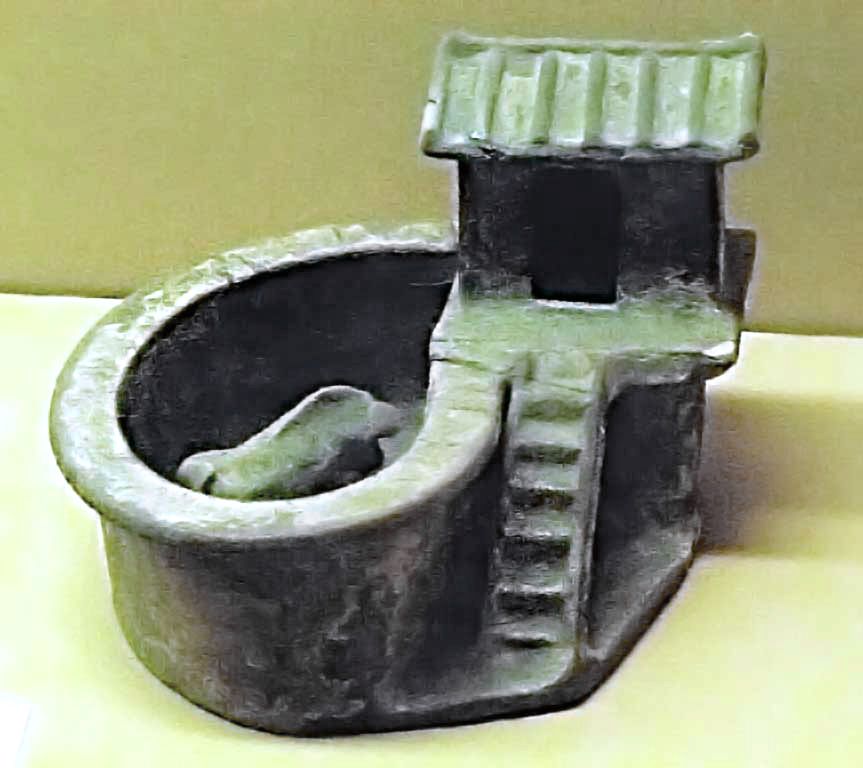The evolution of Chinese toilets
In China, the first type of toilet was simply a hole built in the ground where people would squat. The Chinese character ce, which is currently used in the term “toilet”, has been used in writing for at least 2,000 years but it also meant “pigsty” in many parts of ancient China, because in many areas, toilets were erected next to pigpens, and human feces would slide down a tunnel into the sty to feed the pigs (pig toilets). In some rural areas of China, this practice is still prevalent today.

Northerners typically chose the squat type of toilet when the Chinese started incorporating it into their homes. Squat toilets were practical for holding night soil, which was subsequently used to fertilize fields in North China, where there are frequent water shortages.

However, sitting toilets were more prevalent in regions south of the Yangtze River. Most of them resembled a hole that had been haphazardly dug and had a wooden bench atop it. Although in many locations the bench was little more than a wooden plank or thick branch upon which people were precariously perched, a hole in the board allowed people to go for their business.
Toilet habits were also quite different in cities. The majority of traditional homes in southern cities had separate bathrooms, so occupants typically sat on a sizable matong, or “horse bucket,” which is still a word for a toilet bowl today. Residents would wash the matong with a bamboo brush in a local river every morning after emptying its contents into public bathrooms. Families frequently included a matong in their daughter’s dowry because using the bathroom is an essential aspect of daily living.

In China as recently as the early 1990s, wooden matong and pit toilets were still frequently utilized. Due in large part to unsolved water scarcity issues, many rural regions in the north still use pit toilets instead of flushing toilets today.

Flushing toilets were first employed in China in the latter part of the 19th century by locals in colonial treaty ports where foreign-run municipal authorities set up gas-lit, running-water public restrooms. These initiatives, meanwhile, were limited to the nation’s foreign concessions and failed to appeal to the majority of Chinese citizens.
This was due to two factors. First, China’s cities played a significant role in the manure industry’s supply chain. Night soil collectors would gather the human waste from public restrooms and sell it to farmers in the countryside, who would then spread it on their crops. Modern flushing toilets additionally depend on large sewage systems, which were uncommon in China at the time.
Not until the middle of the 20th century did the government start to use its administrative control over restrooms. The Kuomintang administration started punishing those who urinated or defecated in public places in 1943 and announced a plan to establish public bathrooms throughout the districts under its control. Public sanitation has always been associated with the notion of building a contemporary nation-state, along with other ideas like contemporary health care, physical education, and even fighting against foreign imperialism.
The Patriotic Health Campaign, an initiative that is still going on today, albeit with a new name: the National Hygienic Cities Campaign, was another catalyst for the supply of public sanitation after the Communist Party reunified China in 1949.
The majority of public restrooms in the 1980s were lengthy trenches with squatting areas divided by a number of low dividers. At one end of the trench, a big water tank hung, and when someone flushed their bathroom contents, they also rinsed away everyone else’s. These trench-style restrooms are still in use in several locations today, particularly in former bus and train stations and other locations where large crowds of people frequently gather.

Squat toilets make up the bulk of public restrooms in China nowadays, both in the north and the south. The main reason for this is that squatting toilets are less expensive to construct and maintain than seated ones. Squatting toilets are also said to be more hygienic since they not only reduce bodily contact with the pan but also stop unhealthy activities in a nation where proper sanitary practices are only partially understood. While some Chinese do not aggressively clean up after themselves, many are averse to flushing after using the restroom. Some people, especially ladies, insist on perching on top of the seat when using sitting toilets because of the disgusting condition of some public facilities.
The so-called toilet revolution in China will eventually flood out any residual subpar restrooms, but the availability of public restrooms is still spotty. Squat toilets are typically found in rural China, whereas sitting toilets are typically found in metropolitan regions. Unfortunately, because of the rural-urban difference, the latter type is commonly misapplied.

